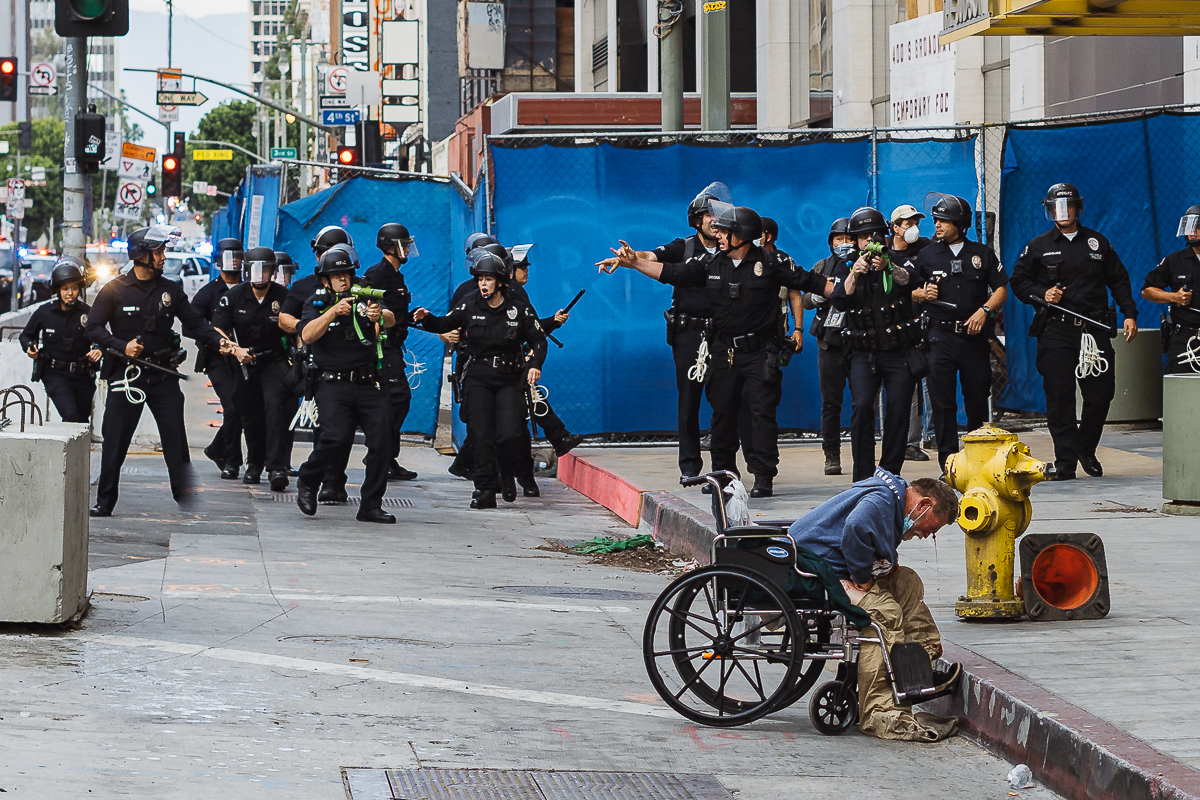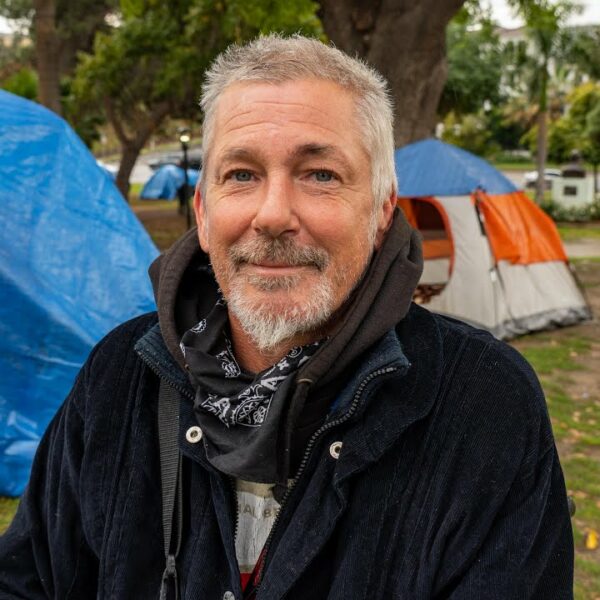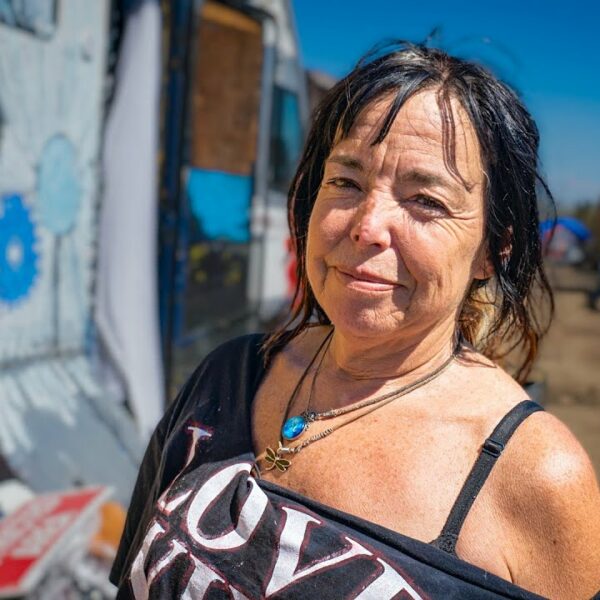Police Hit Bystander Charf Lloyd, a Disabled Homeless Person, in the Head with Rubber Bullet
As our nation begins to question the role of police in society in the wake of the murder of George Floyd and the protests that continue as of this writing, it is important to remember that people experiencing homelessness are also subject to unjust harassment and brutality at the hands of law enforcement.
Due to lack of sufficient housing and other services, many individuals from this population are forced to live outside. Here they are bound to come in contact with officers, especially those assigned to monitor heavily concentrated homeless areas. Unsurprisingly, these interactions and instances of violence are highest in places where homelessness is most criminalized.
Eric Tars, the legal director at the National Law Center on Homeless and Poverty, explained:
“Many activities we take for granted – sleeping, eating, sitting down, resting, going to the bathroom – can be deemed criminal acts when performed by homeless people outside.”
“The correlation we do see is in communities where homelessness is most criminalized – where they have ordinances that are anti-sleeping in public, anti-camping – those are the same places where we’ve seen the highest rates of violent crime [against homeless people],” Tars added.
This over-policing and criminalization of a population with high rates of mental health issues and drug/alcohol abuse can lead to severe consequences. When police lack training on how to interact with these individuals and their specific needs, they cannot effectively deescalate a situation.
Victims of Violence
Although there is currently not much statistical data on the rates police use excessive or fatal force on homeless people, there is substantial evidence of “higher levels of violence against homeless people, including police violence, but not limited to it,” according to Tars.
A recent LAPD report indicated that more than one out of three times an officer used force involved a person experiencing homelessness during the third quarter of 2019. The total number of these instances was 217, a 27% increase from the same time period the previous year. Five of these counts were deemed “categorical use of force”, indicating that the force resulted in a serious injury.
In addition to the many ways LAPD has shown their corruption throughout the unrest, their long-standing treatment of homeless people has been amplified. A lawsuit from Black Lives Matter and other advocates accuses officers of arresting homeless individuals for failure to disperse and/or violating curfew. This is despite having nowhere to go or any way of knowing these regulations were in place to begin with. Furthermore, the lawsuit looks to hold officers accountable for an incident that was shared on social media by a protester that quickly went viral.
Shortly after the 6pm curfew on June 2, LAPD ordered a large group of protesters to disperse near the corner of Broadway and 5th Street. As protesters retreated and entered an open building, they passed by Charf Lloyd on the sidewalk, a disabled homeless person not associated with their group. The wheelchair-bound man watched the group retreat as police turned the corner and began firing rubber bullets intended for those trying to get inside the building. Instead, one of the bullets struck Lloyd in the head, leading to severe bleeding and pain.
Sarah Reingewrtiz, a photographer who was covering the protest, recalled:
“He was just there … it was horrifying to look at.”
In response to this lawsuit, the LAPD has launched a personal investigation into the incident.
While this incident seems shocking, it is only a well-documented, timely example of a larger problem. What happened to Charf Lloyd is an example of the violence people experiencing homelessness are exposed to from law enforcement regularly. Even if the officers involved in this case eventually face punishment for their actions, LAPD will still continue to systematically discriminate against and oppress homeless individuals. Clearly, there needs to be major changes in how the city chooses to address this population.
Reallocating Funding
Defunding the police is a movement that is quickly gaining steam nationwide. Already, Los Angeles Mayor Eric Garcetti has slashed $150 million from the LAPD budget to reinvest into black communities. To compliment investment into these communities, this money should also be used to hire social workers who are more equipped to interact with at-risk populations like homeless people. This would without a doubt inevitably lead to far fewer, if any, uses of force.
Currently, the San Diego City Council is looking to adopt a system implemented by People Assisting the Homeless (PATH). The program employs an outreach worker with a social work background to monitor areas with large homeless populations. Offering food, water, toiletries and other basic necessities, the outreach worker can build relationships with homeless people. Two city council members have seen the success of this program and are looking to apply it as city-wide policy.
A report written by the Corporation for Supportive Housing declared:
“The current approach leads to role confusion and anxiety by people experiencing homelessness, as well as putting undue pressure on limited law enforcement resources … Outreach workers … rather than police, should be first responders regarding unsheltered populations or other outreach-related issues.”
City councilmember Chris Ward, co-chair of the Regional Task Force on the Homeless, added:
“It’s not to diminish the work of police officers, but to take a step forward … we know a lot of individuals are distrustful of the system.”
Dignity, Respect and Understanding = Positive Outcomes
What is currently being discussed in the San Diego City Council should be brought up in local government at every level, especially those with a large homeless population. Los Angeles County, home to almost 60,000 individuals experiencing homelessness, is one of the areas that could benefit the most. This is a first step that will lead to positive outcomes. When these people are treated with dignity, respect and understanding, they are more likely to receive the services they need, alleviating the issue.
Editor’s note: The photo featured with this article is given courtesy of FWDSET | Kirk Tsonos. Kirk said all proceeds made from the sale of the photo are being donated to Black Lives Matter. He also started an online fundraiser for Charf Lloyd.













